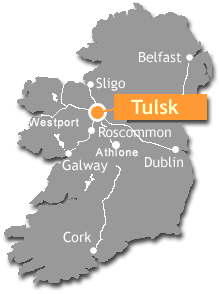Firstly, we must note some of the extant monuments. The Carns complex has at its nucleus the mound of Carnfree, and it is from this central point that we can view the rest of the landscape, as it is located, quite literally, at the high point of a ridge at approximately 120m above sea level. The mound of Carnfree (Carn Fraích) is deemed to be prehistoric in origin, it being a cairn of stones and other material said to mark the burial of the great Connacht warrior of the Ulster Cycle of tales, Fraoch.
 |
| Carnfree Mound (Image courtesy of Rathcroghan Visitor Centre) |
This cairn was identified by John O'Donovan in the 19th-century as being the famed inauguration place of the O'Conor kings of Connacht. Despite it's seemingly modest appearance, it's elevated prominence over the surrounding region indicates at it's veracity, particularly considering the usual practice of locating inauguration places at commanding viewpoints of a region. More than this, Carnfree's associations with a legendary legitimising ancestral figure, and Carns' obvious location in close vicinity and direct line of sight to the prehistoric royal landscape of Rathcroghan, attests to Carnfree's importance as a place of ceremonial assembly and inauguration for a prominent Gaelic royal dynasty.
Moving from Carnfree to the west we have the conjoined earthwork, figure-of-eight monuments of Duma Selga. This fascinating combination of ringfort and ring-barrow gives immediate thought to the great joining of Tech Cormaic and the Forrad on the Hill of Tara in Co. Meath. This incorporation of enclosure/settlement and burial/ceremonial mound is something we also see at Caran Fort on the Rathcroghan complex, and at Rathbrennan, close to Roscommon Town, among others. The conjoined nature of the features at Duma Selga suggests that there might have been two, or indeed more, phases of archaeology at the monument, with the second phase deemed to be one of settlement or perhaps a building of more temporary use. Magnetic susceptibility uncovered several high values that may be evidence of heavy burning. Magnetic gradiometry and electrical resistance surveys indicate a possible structure in a similar area to the 'burning' on the ringfort. Coupling this data with Bishop Tírechán's (7th-century) account of St. Patrick coming to Selc to the sons of Brión, and references in the Metrical Dindshenchas to the past glories of the royal barrow of Duma Selga, all suggest to this set of monuments being of central importance to Carns, and the region at large.
 |
| Duma Selga (Image courtesy of M. Casey) |
To the south-east of Carnfree mound lies Carn Láma. Carn Láma is a large, grass-covered tumulus, measuring 18.5m in diameter at the base, and is said to contain the remains of the warrior Fraoch's hand. It stands at 3.7m above the surrounding landscape, and has the remains of a distinctive step running around the base of the mound. Surveying on the summit of the mound uncovered areas of ever increasing high values, which may be due to the use of sod and topsoil in its construction, but the very high values may indicate an episode of heavy burning. It has been theorised that this may even have been due to some industrio-ritual activity, where a society continues to hold a level of significance to particular existing funerary monuments for activities such as ironworking.
 |
| Carn Láma (Image courtesy of M. Casey) |
Excavation by the Discovery Programme at the Ecclesiastical Site of Carns provided strong evidence of a very long period of use and reuse. The earliest available evidence comes in the form of another, large 'figure of eight' structure, which could have a date from the late prehistoric or early historic period. This was uncovered through the application of a magnetic gradiometry survey. Our next possible phase of interaction with the immediate area at Carns comes with the discovery of a standing stone inscribed with ogham, which would date interaction to the 5th or 6th-century.
 |
| Carns Ecclesiastical Site (Image courtesy of Michael Herity) |
A building platform of 11th-century date was uncovered, possibly the foundations of a dwelling, which was then chronologically succeeded by a large, two-celled 15th or16th-century church. All of this was contained within a two metre thick drystone wall, which had an earlier ditch located within the perimeter of the wall. This repeated interaction with the area is testament to it's importance over several generations, and indeed, centuries.
 |
| Cloch Fada na gCarn (Image courtesy of Rathcroghan Visitor Centre) |
Aside from these spotlighted monuments, Carns is also home to a number of other prehistoric funerary monuments, the most prominent being topped with a 3m tall standing stone, the Cloch Fada na gCarn. (the Long Stone of Carns). There is also evidence for a moated site which has been attached to an earlier ringfort, as well as an 18th-century sean baile, which must represent the last phase of pre-modern interaction with the Carns Archaeological Complex. Daniel Curley.



No comments:
Post a Comment